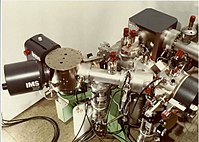
Photo from wikipedia
PurposeLateral mass screws combined with rods are the standard method for posterior cervical spine subaxial fixation. Several techniques have been described, among which the most used are Roy Camille, Magerl,… Click to show full abstract
PurposeLateral mass screws combined with rods are the standard method for posterior cervical spine subaxial fixation. Several techniques have been described, among which the most used are Roy Camille, Magerl, Anderson and An. All of them are based on tridimensional angles. Reliability of freehand angle estimation remains poorly investigated. We propose a new technique based on on-site spatial references and compare it with previously described ones assessing screw length and neurovascular potential complications.MethodsFour different lateral mass screw insertion techniques (Magerl, Anderson, An and the new described technique) were performed bilaterally, from C3 to C6, in ten human spine specimens. A drill tip guide wire was inserted as originally described for each trajectory, and screw length was measured. Exit point was examined, and potential vertebral artery or nerve root injury was assessed.ResultsMean screw length was 14.05 mm using Magerl’s technique, 13.47 mm using Anderson’s, 12.8 mm using An’s and 17.03 mm using the new technique. Data analysis showed significantly longer lateral mass screw length using the new technique (p value < 0.00001). Nerve potential injury occurred 37 times using Magerl’s technique, 28 using Anderson’s, 13 using An’s and twice using the new technique. Vertebral artery potential injury occurred once using Magerl’s technique, 8 times using Anderson’s and none using either An’s or the new proposed technique. The risk of neurovascular complication was significantly lower using the new technique (p value < 0.01).ConclusionThe new proposed technique allows for longer screws, maximizing purchase and stability, while lowering the complication rate.Graphical abstract
Journal Title: European Spine Journal
Year Published: 2018
Link to full text (if available)
Share on Social Media: Sign Up to like & get
recommendations!